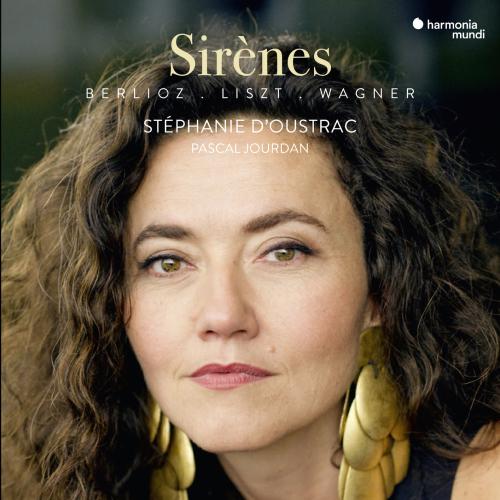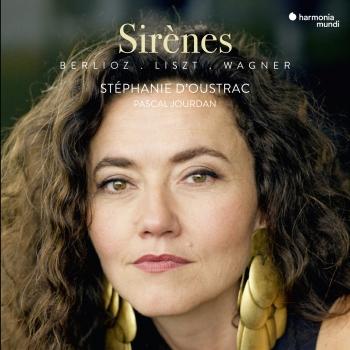
Album info
Album-Release:
2019
HRA-Release:
01.03.2019
Label: Harmonia Mundi
Genre: Classical
Subgenre: Vocal
Artist: Stéphanie d'Oustrac & Pascal Jourdan
Composer: Richard Wagner (1813-1883), Ferencz Liszt (1811-1886), Hector Berlioz (1803-1869)
Album including Album cover Booklet (PDF)
- Franz Liszt (1811 - 1886):
- 1 Die Loreley, S. 273/2 06:07
- 2 Freudvoll und leidvoll, S. 280/1 02:17
- 3 Es war ein König in Thule, S. 278/2 02:50
- 4 Im Rhein, im schönen Strome, S. 272/2 02:52
- 5 Freudvoll und leidvoll, S. 280/2 03:10
- 6 Über allen Gipfeln ist Ruh, S. 306/2 03:52
- Hector Berlioz (1803 - 1869): Les Nuits d'été, Op. 7, H. 81A:
- 7 Les Nuits d'été, Op. 7, H. 81A: 1. Villanelle, H. 82 02:35
- 8 Les Nuits d'été, Op. 7, H. 81A: 2. Le Spectre de la rose, H. 83 06:20
- 9 Les Nuits d'été, Op. 7, H. 81A: 3. Sur les lagunes, Lamento, H. 84 06:06
- 10 Les Nuits d'été, Op. 7, H. 81A: 4. Absence, H. 85 04:43
- 11 Les Nuits d'été, Op. 7, H. 81A: 5. Au cimetière, Clair de lune, H. 86 05:58
- 12 Les Nuits d'été, Op. 7, H. 81A: 6. L'Île inconnue, H. 87 03:23
- Hector Berlioz:
- 13 La Mort d'Ophélie, Op. 18, No. 2, H. 92A 06:11
- Richard Wagner (1813 - 1883): Wesendonck-Lieder, WWV. 91:
- 14 Wesendonck-Lieder, WWV. 91: 1. Der Engel 02:57
- 15 Wesendonck-Lieder, WWV. 91: 2. Stehe still 03:31
- 16 Wesendonck-Lieder, WWV. 91: 3. Im Treibhaus 06:16
- 17 Wesendonck-Lieder, WWV. 91: 4. Schmerzen 02:26
- 18 Wesendonck-Lieder, WWV. 91: 5. Träume 04:13
Info for Sirènes
In recording this first recital for harmonia mundi, Stéphanie d'Oustrac and Pascal Jourdan wished to measure themselves against three cornerstones of Romantic music, three composers who each in their own way made a decisive contribution to the evolution of the lied (Liszt), or even to the birth of the French mélodie, in the case of Berlioz’s Les Nuits d’été. Much more widely known intheir sumptuous orchestration, these songs take on a completely different dimension when accompanied by the sobriety of a piano. This artistic approach found its ultimate resonance in the five Wesendonck-Lieder, which Wagner originally intended as a simple duo for voice and piano, though they were eventually to form one of the most famous cycles in the history of the lied.
Stephanie d'Oustrac, mezzo
Pascal Jourdan, piano
Stéphanie d’Oustrac
First revealed to the public by William Christie in Lully’s Thésée at the Am- bronay European Baroque Academy of 1998, Stéphanie d’Oustrac has become a leading personality in the world of Baroque music. After studying drama at the Conservatoire National Régional in Rennes, she took advanced courses in singing at the Conservatoire National Supérieur de Musique et de Danse in Lyon. She appears with equal success on the concert platform and on the lyric stage, in Baroque and Classical opera and in operetta. Her ardent temperament in any role she plays immediately brought her to the attention of critics and audi- ences alike.
The numerous parts she has tackled naturally include the title role in Bizet’s Carmen (in 2010), but among other highlights of her career have been Ot- tavia in Monteverdi’s L’incoronazione di Poppea; Lully’s Armide; Marc-Antoine Charpentier’s Médée; Dido in Purcell’s Dido and Aeneas; Ruggiero in Alcina and Sesto in Giulio Cesare (Handel); Zerlina in Don Giovanni, Cherubino in Le nozze di Figaro, Ida- mante in Idomeneo, and Sesto in La clemenza di Tito (Mozart); Rosina in Il barbiere di Siviglia and Isolier in Le Comte Ory (Rossini); the title roles in Offenbach’s La Périchole and La Belle Hélène and Britten’s solo cantata Phaedra; Concepcion in Ravel’s L’Heure espagnole; and Mélisande in Debussy’s Pelléas et Mélisande.
Stéphanie d’Oustrac has sung under the direction of William Christie, Gabriel Garrido, Jean-Claude Malgoire, Marc Minkowski, Sir John Eliot Gardiner, Myung-Whun Chung, Hervé Niquet, Christopher Hogwood, René Jacobs, Alan Curtis, Jesús López Cobos, Jean-Claude Casadesus, Sir Colin Davis, Charles Dutoit, Ádám Fischer, and many others.
She has appeared in the most prestigious venues, in- cluding the Théâtre du Châtelet, Opéra Comique, and Théâtre des Champs-Élysées in Paris; the Ambronay, Aix- en-Provence, Glyndebourne, and Saint-Denis festivals; the opera houses of Lille, Marseille, Bordeaux, Montpel- lier, Lyon, Baden-Baden, Amsterdam, Rome, and Luxem- bourg; the Grand Théâtre in Geneva, the Barbican Centre in London, and the Bunkamura Hall in Tokyo.
Stéphanie d’Oustrac is one of the key artists of the Am- bronay Éditions label: her Haydn disc Arianna a Naxos was acclaimed by the critics on its release in 2010, and was named ffff in Télérama, Editor’s Choice in Gramo- phone, 5 Diapason, M of Mezzo, and Clé de Resmusica. The following disc, Ferveur & Extase, recorded in 2011 with the ensemble Amarillis, received the Diamant d’Or from Opéra Magazine and 5 Diapason.
Pascal Jourdan
studied the piano at the Conservatoire National Supérieur de Musique de Lyon with Eric Heidsieck (graduating with the DNESM), then with Roger Muraro (postgraduate course), as well as analysis and harmony and counterpoint with Gérard Gastinel and chamber music with Michele Scharapan. He is also a graduate of the Accademia Nazionale Santa Cecilia in Rome. In parallel with these studies, from 1990 to 1997, he received tuition from Éliane Richepin.
A noted chamber musician, he is a member of the Trio Elias and Trio Novalis. His passion for the lied and mélodie repertoire is reflected in his artistic partnership with the mezzo-soprano Stéphanie d’Oustrac, with whom he has worked for the past twenty years.
He has won prizes at several international competitions (Trio di Trieste, Musique de Chambre de Lyon, Ragusa-IBLA, Fondation Cziffra) and from Mécénat Société Générale, and has recorded fre- quently for radio and television (France Musique, Radio Suisse Romande, RTBF, Radio Canada, ABC, Mezzo, RAI, RFO, France 2, France 3).
He has appeared in some twenty countries in Europe, Asia, and Australia, in prestigious concert halls in Lyon, Paris, Geneva, Bruges, Florence, Oxford, Rome, Bucharest, Salzburg, Bangkok, Sendai, Tokyo, Fukuoka, Melbourne, and Sydney, and at such festivals as La Roque d’Anthéron, Ambronay, Rencontres Musicales de Haute-Provence, Musicades, Montpellier-Radio France, and Bangkok Ibicus Concert Series, etc.).
Pascal Jourdan has taught at the Conservatoire à Rayonnement Régional de Montpellier since 1999.
Booklet for Sirènes









